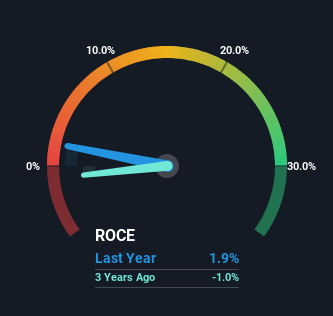- Singapore
- /
- Hospitality
- /
- SGX:M04
Mandarin Oriental International (SGX:M04) Could Be Struggling To Allocate Capital

To find a multi-bagger stock, what are the underlying trends we should look for in a business? Amongst other things, we'll want to see two things; firstly, a growing return on capital employed (ROCE) and secondly, an expansion in the company's amount of capital employed. This shows us that it's a compounding machine, able to continually reinvest its earnings back into the business and generate higher returns. Having said that, from a first glance at Mandarin Oriental International (SGX:M04) we aren't jumping out of our chairs at how returns are trending, but let's have a deeper look.
Return On Capital Employed (ROCE): What Is It?
If you haven't worked with ROCE before, it measures the 'return' (pre-tax profit) a company generates from capital employed in its business. The formula for this calculation on Mandarin Oriental International is:
Return on Capital Employed = Earnings Before Interest and Tax (EBIT) ÷ (Total Assets - Current Liabilities)
0.019 = US$65m ÷ (US$4.2b - US$759m) (Based on the trailing twelve months to June 2023).
Therefore, Mandarin Oriental International has an ROCE of 1.9%. In absolute terms, that's a low return and it also under-performs the Hospitality industry average of 3.9%.
Check out our latest analysis for Mandarin Oriental International

Historical performance is a great place to start when researching a stock so above you can see the gauge for Mandarin Oriental International's ROCE against it's prior returns. If you're interested in investigating Mandarin Oriental International's past further, check out this free graph of past earnings, revenue and cash flow.
So How Is Mandarin Oriental International's ROCE Trending?
On the surface, the trend of ROCE at Mandarin Oriental International doesn't inspire confidence. Around five years ago the returns on capital were 4.5%, but since then they've fallen to 1.9%. Although, given both revenue and the amount of assets employed in the business have increased, it could suggest the company is investing in growth, and the extra capital has led to a short-term reduction in ROCE. And if the increased capital generates additional returns, the business, and thus shareholders, will benefit in the long run.
What We Can Learn From Mandarin Oriental International's ROCE
While returns have fallen for Mandarin Oriental International in recent times, we're encouraged to see that sales are growing and that the business is reinvesting in its operations. These growth trends haven't led to growth returns though, since the stock has fallen 15% over the last five years. So we think it'd be worthwhile to look further into this stock given the trends look encouraging.
If you'd like to know about the risks facing Mandarin Oriental International, we've discovered 1 warning sign that you should be aware of.
For those who like to invest in solid companies, check out this free list of companies with solid balance sheets and high returns on equity.
New: Manage All Your Stock Portfolios in One Place
We've created the ultimate portfolio companion for stock investors, and it's free.
• Connect an unlimited number of Portfolios and see your total in one currency
• Be alerted to new Warning Signs or Risks via email or mobile
• Track the Fair Value of your stocks
Have feedback on this article? Concerned about the content? Get in touch with us directly. Alternatively, email editorial-team (at) simplywallst.com.
This article by Simply Wall St is general in nature. We provide commentary based on historical data and analyst forecasts only using an unbiased methodology and our articles are not intended to be financial advice. It does not constitute a recommendation to buy or sell any stock, and does not take account of your objectives, or your financial situation. We aim to bring you long-term focused analysis driven by fundamental data. Note that our analysis may not factor in the latest price-sensitive company announcements or qualitative material. Simply Wall St has no position in any stocks mentioned.
About SGX:M04
Mandarin Oriental International
Engages in the ownership and operation of hotels, resorts, and residences in Asia, Europe, the Middle East, Africa, and the Americas.
Excellent balance sheet with weak fundamentals.
Similar Companies
Market Insights
Community Narratives



